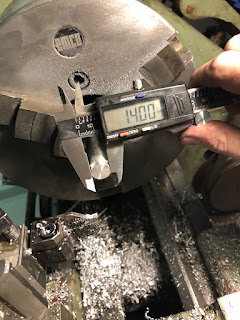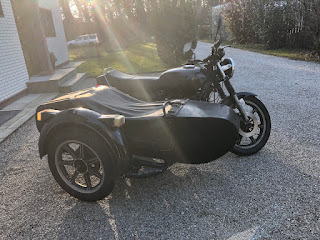So I am going back to 31mm* snowmobile carbs and no it's not that I wasn't happy with the modified Gixxer flatslides, but to be honest I will need them next year on a mighty four that has been lurking way too long in another shed. (*Yes, previous iterations used 33mm snowmobile carbs, but I have sufficient carbs to make a 4-carb rack of those and only a single 31mm rack with three carbs, also torque is more important than outright horsepower on a sidecar once you reached a certain point.)
As usual they were properly mangled and not much use to me in their stock
form.
This time I tackled the task differently than last time, because I wanted to use all the original inlets or at least the cast bosses as first I broke through the casting last time on one carb and second a fuel line in the way of the throttle cable during installation is no fun at all.
The one bit not shown is how I aligned the casting in the mill with a drill
bit snuggly fitting into casting before milling the remnants of the pressed in
fitting flat and then drilling it out.
Tapped M8x1.0 (standard hydraulics banjo bolt and banjo) and then after
tapping gave it one more lick with a milling cutter to make sure the surfaces
were square.
Milled down the boss on the left carb and there you go, enough room for the
fitting. Don't think you could get it out with the carbs as a rack though.
(But then again that was not the objective.) Also spot the challenge that came
from turning a right into a left carb. The throttle-shaft hole is plugged.
Luckily in terms of the right carb, it is only plugged and can be knocked out with moderate force. (It's a nice press-fit though.)
It's a completely different story on the other end of the rack. Turning a left into a right carb involves a fair bit of thinking and machining.
The first step was moderately easy once I summoned all my bravery to just drill into the casting. (As can be seen, I first tried to do a sort of lineboring job, but that didn't work, so I aligned a 16mm endmill with the casing and did what I had to do.)
Fun starts with the insert that needs to go in there. Because it has to be an inside and outside press-fit and has not too much wall thickness left, so each of the two will affect each other, if I c*ck it up. (Spoiler from this point onwards I do consider myself a proper engineer.) So turn it to 16.55mm as the bore in the case is slightly out of round and measures 16.52mm at the widest point.
Then took the seal out of the carb body. It's a relatively normal 10x14x3mm lip-seal and if it weren't for a lockdown, I could buy one of these over the counter, if I screwed up. As can be seen, it checks out to 14.08mm and goes into a 14.00 hole. (So Mikunis press-fit was chosen a lot tighter than mine.)
Test fit on the lathe - wall thickness around 0.75mm (16.55-14.00mm) and yes, it distorts with the seal inserted. So I gave it another lick on the lathe and at least at that point it was round again.
Pressed into the casing, thanks to a light taper on the backside, it centered nicely and started with finger pressure.
Couple of tap-taps later and it sat all the way in and the shaft didn't bind up.
Making a solid 4mm tall, 14.00mm plug for a 13.95mm hole was almost relaxing at this point. Also, MGEHR-tools leave a beautiful finish. The 14.00mm were hit going straight down from 15.1x and this was the moment, when my ego politely pointed out that it was due for its own postcode.
Same trick, slight taper on the backside to get it started and the a few love taps to drive it all the way in afterwards.
The plan (obviously) was to use the throttle shaft I made for the Gixxer carbs and to be fair, I think that wasn't too outlandish to think it would work. Well, it didn't all holes are just a tad off to these.
So I did it all again (sorry no photos, it's boring...)
Not sure, why I altered the throttle cable mount last time, but it clears just fine, so it'll stay (almost) stock.
And that's the finished product - aside from painting the carb tops black and making an extension to the idle adjuster shaft.
Fuel line is now a pretty straight forward affair and the horizontal section will be zip-tied to the rail.
So there you have it - bit more work necessary to get it finished and I have to come up with something smart regarding the throttle cable to give it the 90 bend it needs for perfection, but in all honesty this should be the hard part done.




















































